Mobile Gaming Statistics By Origin, Market Size, Trends and Facts (2025)

Updated · Oct 08, 2025


WHAT WE HAVE ON THIS PAGE
- Introduction
- Editor’s Choice
- Mobile Gaming Monetization Strategies By IAP vs In-Game Ads
- Mobile Gaming by Genre- Downloads and Revenue Dominance
- Mobile Gaming Market Size
- Regional Mobile Gaming Market Breakdown
- Mobile Gaming Demographics and Player Behaviour
- Leading Mobile Gaming Titles by Downloads and Revenue
- The Future of Mobile Gaming: Mobile Esports and Innovation
- Conclusion
Introduction
Mobile gaming statistics: The mobile gaming sector has definitively positioned itself as the single most powerful revenue engine in the global entertainment economy, surpassing both PC and console segments combined.
Its meteoric rise is a direct consequence of global smartphone saturation, the proliferation of high-speed 5G networks, and a shift in the market towards highly accessible, free-to-play models. Modern mobile gaming has evolved far beyond simple, casual time-killers into deep, long-form core experiences that are changing everything from social interaction to competitive eSports.
In this comprehensive report, I’d like to discuss the essential, up-to-date mobile gaming statistics, providing data that proves the market’s current scale, regional dominance, genre-specific profitability, and evolving player demographics. Without further ado, let’s get started.
Editor’s Choice
- Mobile gaming is the largest sector of the global gaming industry, generating an estimated $92 billion in 2024.
- This figure represents nearly 49% of the entire global market, surpassing the combined revenue of PC and console gaming.
- The active global population of mobile gamers currently stands at 2 billion, projected to grow to 3.5 billion by the end of 2025.
- The highest-grossing title in 2024 was Monopoly Go!, which generated an unprecedented estimated revenue of $2.2 billion from in-app purchases IAP.
- The Asia-Pacific region remains the geographical powerhouse, contributing approximately $88.1 billion to global mobile gaming revenue.
- The strategy genre was the top revenue generator, pulling in an impressive estimated $17.5 billion.
- This is because strategy titles account for only about 4% of total game downloads.
- The average age of a dedicated mobile gamer is approximately 3 years.
- Furthermore, women make up roughly 55% of the US mobile gaming audience.
- The competitive mobile gaming Esports market is poised for explosive growth, projected to increase from $847.70 million in 2025 to $8.62 billion by 2034.
- Driven by a compound Annual Growth Rate CAGR of 4%, total global time spent in mobile games increased by 8% in 2024.
Mobile Gaming Monetization Strategies By IAP vs In-Game Ads
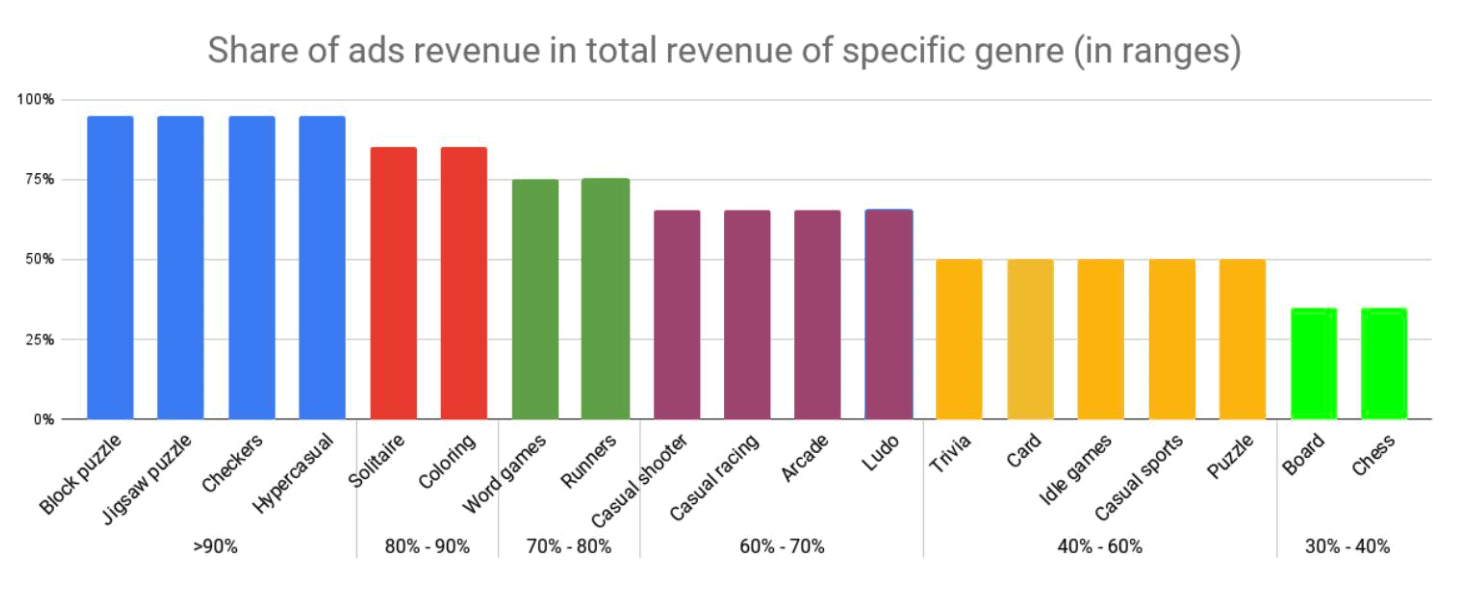
- The In-Game Advertising IAA market reached a valuation of approximately $9.84 billion in 2024. This segment is projected to grow to a massive $18.23 billion by 2029.
- Hybrid monetization strategies, which strategically blend IAP and IAA, are becoming the default for a majority of mobile publishers, with some experts debating optimal splits like 70% IAA to 30% IAP for hyper-casual titles.
- The overall in-game advertising revenues are forecasted to show a strong annual CAGR of 9.9% between 2023 and 2027, eventually reaching an estimated market value of $145.5 billion.
- iOS users consistently demonstrate higher spending power; despite having a smaller global user base than Android, the platform generated nearly 65% of global mobile gaming revenue in 2024.
- Conversely, Android maintains dominance in volume, accounting for over70% of total global mobile game downloads, driven by its broader accessibility in emerging markets.
- The average eCPM, effective Cost Per Mille for Rewarded Ads, the highest performing aspect, has notably increased, reflecting rising competition among advertisers for high-value user impressions.
- In a significant shift following Apple’s privacy changes, Android’s share of global ad revenue has risen, with the US market on Android holding a 33% share of its ad revenue, compared to a highly concentrated 55% share on iOS.
- In-game purchases represent the largest individual revenue stream for the total gaming market, accounting for a majority share of approximately 63.4% of market revenue in 2024.
| IAP Market Share | 63.4% of total gaming market revenue |
| IAA Market Value 2024 |
$9.84 Billion |
|
IAA Market Projection 2029 |
$18.23 Billion 13.4% CAGR |
| iOS vs Android Revenue Split |
iOS generates roughly 65% of global mobile game revenue despite fewer users |
|
Android Download Share |
Accounts for over 70% of global mobile game downloads |
| Rewarded Ad Performance |
eCPM rates have increased, driven by higher user value from hybrid-casual models. |
Mobile Gaming by Genre- Downloads and Revenue Dominance
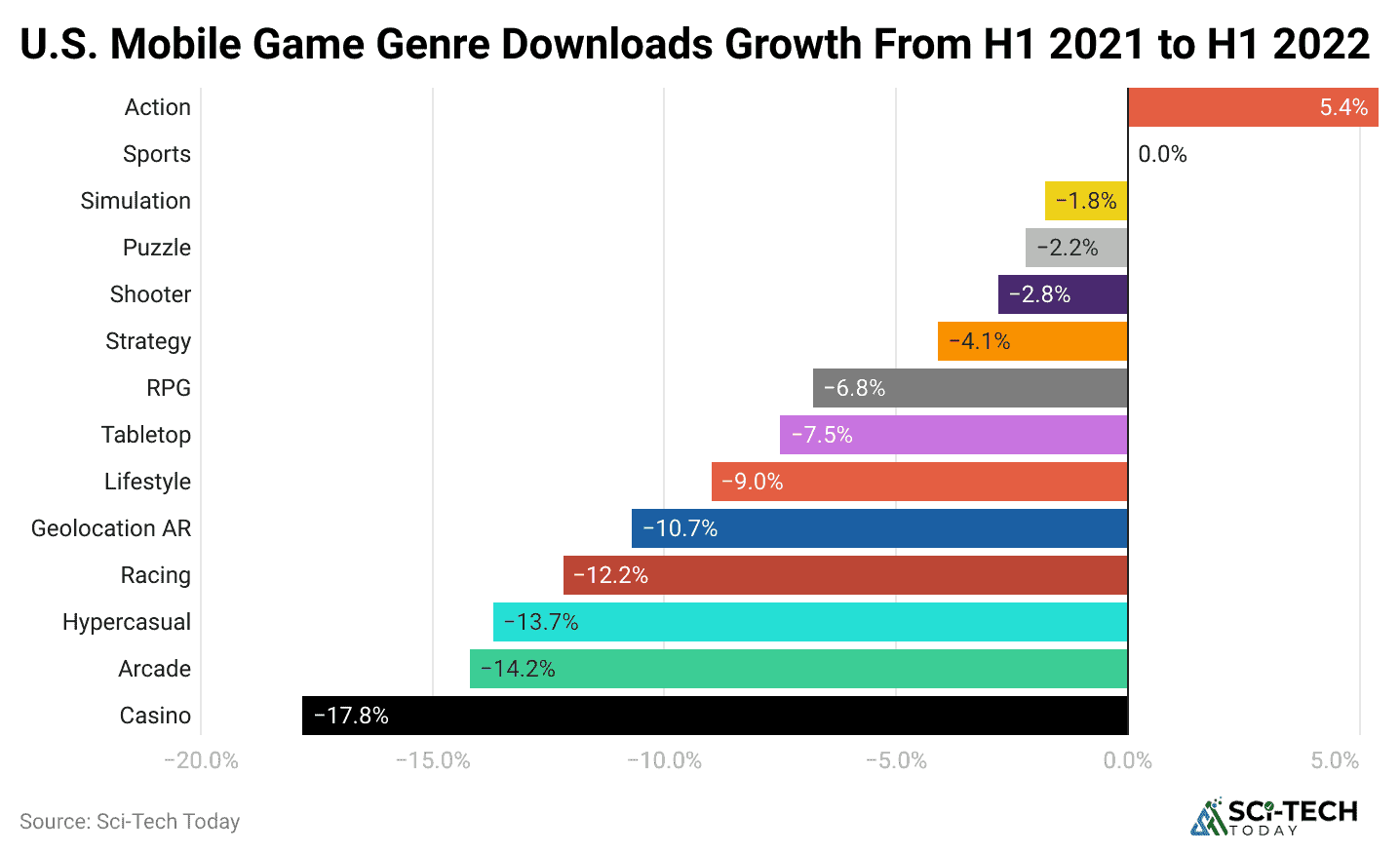
- In terms of downloads, the Simulation and Puzzle genre leads the pack, each capturing approximately 20% of total global downloads in 2024, with simulation games hitting around 9.8 billion downloads.
- Despite lower download volume, the strategy genre emerged as the top revenue generator in 2024, pulling in an impressive estimated $17.5 billion.
- The Role-Playing Games RPG genre follows closely as the second most profitable, generating a massive $16.8 billion in 2024.
- A classic, downloads vs. revenue paradox is evident, as strategy games made up a substantial 21.4% of total revenue while only accounting for about 4% of all global mobile game downloads.
- Hyper-casual games, which are focused on simple mechanics and high install volume, saw a significant YoY decline of 24% in downloads in the final quarter of 2022.
- Puzzle games, a staple of the casual market, still proved to be a powerhouse, securing the third spot in revenue with $12.2 billion in 2024, driven by mega-hits like Royal Match and Block Blast.
- The Action genre continues to lead in user engagement with the longest average session length, clocking in at an impressive 45.15 minutes per session.
- In the competitive sub-genres, Shooter games remain the most popular choice for the 16 to 64 age group.
| Strategy | $17.5 billion highest revenue | 4% of total downloads |
| RPG | $16.8 billion 2nd h2nd-highestrevenue | Mid-Volume |
| Puzzle | $12.2 billion 3,rd highest revenue | 9.7 billion 20% of total downloads |
| Simulation | $6.1 billion | 9.8 billion 20% of total downloads |
| Action | $3.6 billion | Low-volume |
Mobile Gaming Market Size
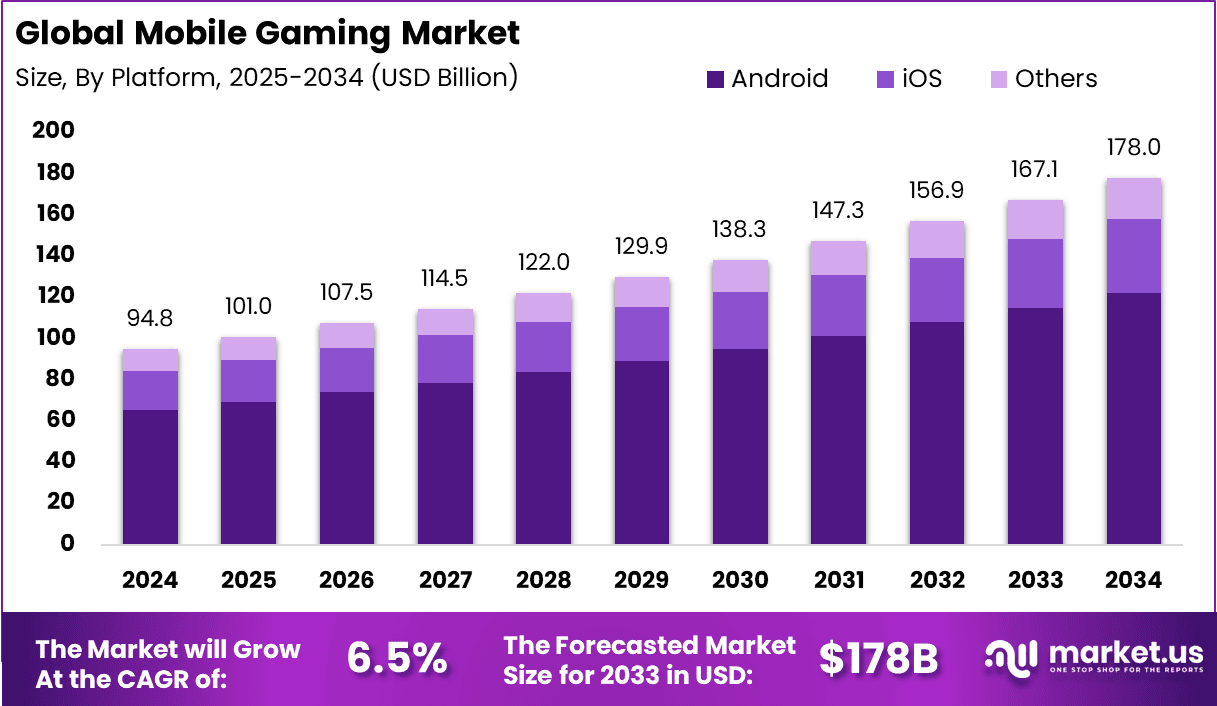
According to Market.us, the financial scale of Mobile Gaming is unprecedented, and recent data shows a clear stabilization and return to growth after a slight post-pandemic correction period in 2022 to 2023. This is driven by increasingly sophisticated game economies and a massive, engaged user base.
- The total global gaming industry generated over $187.7 billion in revenue in 2024, with mobile gaming contributing the dominant share of approximately $92 billion.
- This colossal revenue figure of $92 billion for mobile gaming in 2024 represented a healthy +3.0% YoY growth, signaling market stability and renewed expansion.
- Industry analysts project the total global revenue for the mobile gaming market to climb significantly, with forecasts indicating a market valuation reaching roughly $160 billion by the end of 2030.
- Despite a minor decline in new installs, total global mobile game downloads still amounted to an immense 49 billion in 2024, illustrating the volume of player engagement.
- The Average Revenue Per Paying User ARPPU in the mobile gaming market is consistently on the rise, suggesting that a smaller, more dedicated group of players is responsible for the lion’s share of in-app purchase spending.
- The number of new game releases declined sharply by 43% in 2024, falling from 222,000 new titles in 2023 to 126,000, as developers shifted focus to sustaining and monetizing higher-quality, long-term titles.
- Global time spent in mobile games increased by 8% in 2024, showing that while players may be downloading fewer new titles, they are dedicating significantly more time to their favorite established games.
- In-app purchases IAP and subscription revenue across all apps grew by a substantial 13% year-over-year in 2024, with the majority of this growth being fueled directly by the mobile gaming segment.
| 2024 Total Revenue | $92 Billion |
| 2030 Revenue Projection | $160 Billion |
| 2024 Annual Downloads | 49 Billion down 7% YoY |
| Growth Rate 2024 YoY | +3.0% |
| New Release Decline 2024 | -43% vs 2023 |
| Increase in Time Spent | +8% |
Regional Mobile Gaming Market Breakdown
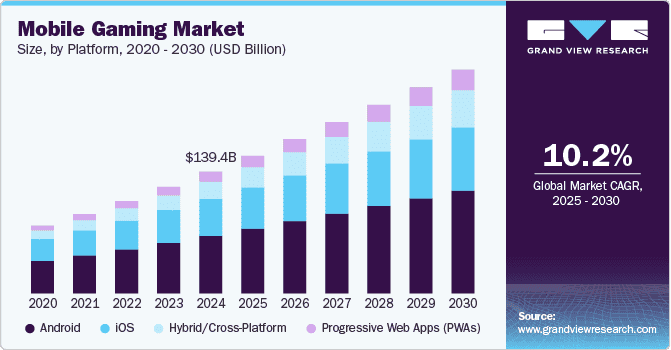
According to Grand View Research, the mobile gaming market is profoundly global, but its revenue is highly concentrated, with Asia-Pacific maintaining a decisive lead, while emerging markets in Latin America and the Middle East are accelerating at the fastest rates.
- The Asia-Pacific APAC region is the undeniable global leader, commanding a total game revenue of approximately $88.1 billion in 2024, nearly half of the entire global market.
- North America demonstrated a steady year-over-year growth, with its market revenue reaching $50.6 billion and seeing a +1.7% YoY increase, driven primarily by the high-spending US audience.
- Europe’s market is also substantial, accounting for $33.6 billion in game revenue in 2024, a modest growth of +0.8% YoY, making it a key focus for premium game advertising.
- The United States stands alone as the single largest country market by In-App Purchase IAP revenue, with consumer spending reaching an astronomical $52 billion in 2024.
- Mainland China is the second-largest IAP market, with spending hitting an estimated $25 billion in 2024, primarily driven by a highly regulated and concentrated domestic market for core games.
- Emerging markets are experiencing the most explosive revenue growth, with Turkey reporting a spectacular +28% YoY revenue increase, Mexico rising by +21%, and India showing a strong +17% surge.
- In the massive Indian market, mobile gaming accounts for over 90% of the country’s total gaming revenue, underpinned by a tech-enthusiast youth demographic of over 600 million people under the age of 35.
- Markets in Latin America and the Middle East and North Africa MENA are outperforming established regions, with a reported 8 to 10% increase in game app installs and a 5 to 7% rise in session volume in 2024.
| Asia-Pacific APAC | $88.1 Billion Global Leader |
| United States | $52 Billion Highest Single-Country IAP Revenue |
| North America | $50.6 Billion |
| Turkey | Emerging Market |
| India | High Download Volume |
Mobile Gaming Demographics and Player Behaviour
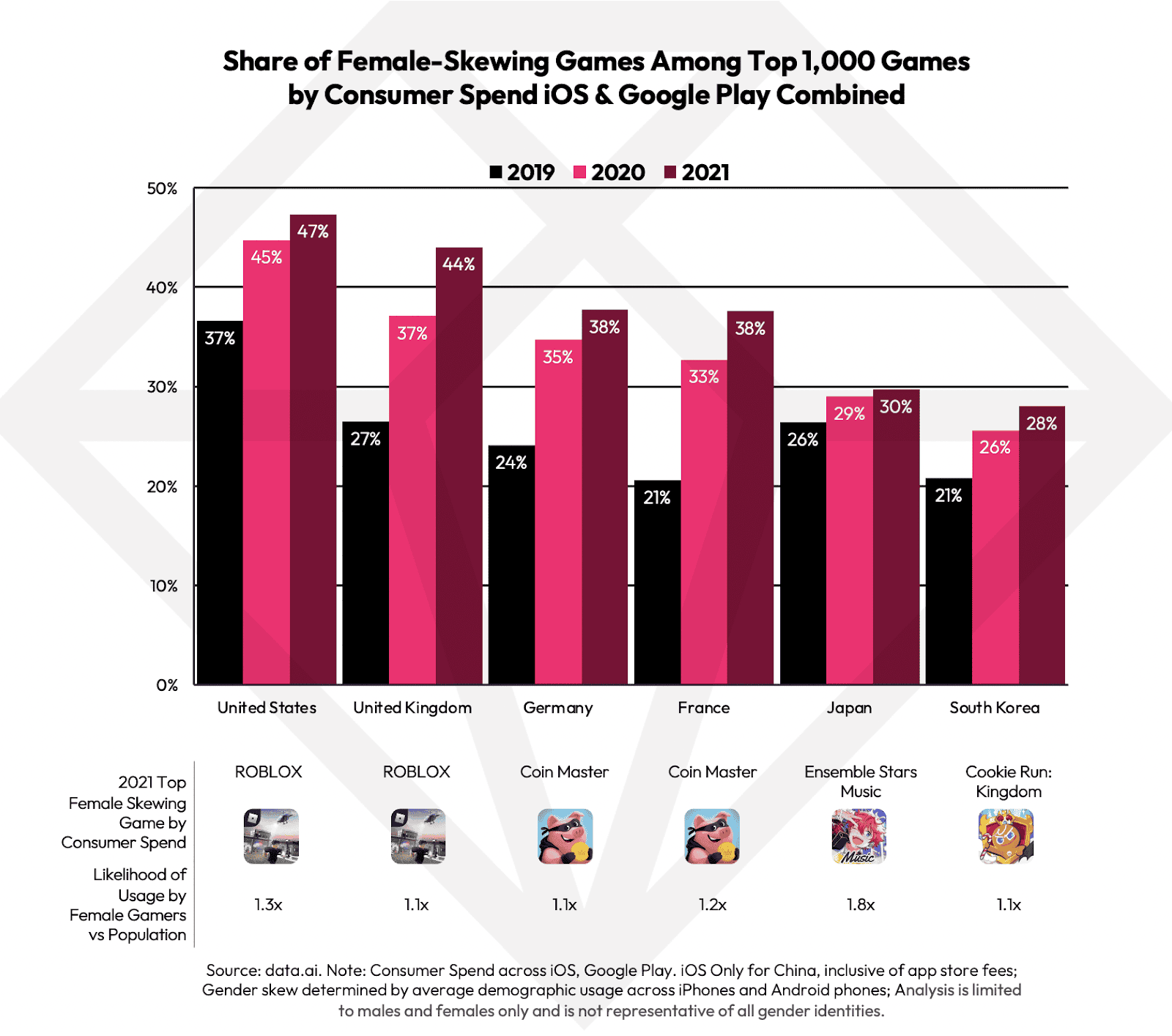
- The global number of active mobile gamers stands at an impressive 3.2 billion, a figure that represents almost half of the world’s total population and is expected to climb to 3.5 billion by 2025.
- The average age of a mobile gamer is now estimated to be 36.3 years, shattering the myth that gaming is solely the domain of teenagers and young adults.
- A significant 85% of people who play mobile games do not self-identify as gamers, highlighting the mass-market, casual nature of the platform’s user base.
- The dominant age group for mobile gaming is the 25 to 34 bracket, which makes up about 29.5% of the total mobile gamer population, closely followed by the 16 to 24 group at 28.3%.
- Women now constitute a majority of the mobile gaming audience, with roughly 55% of US players being female, and they tend to have gaming sessions that are 25% longer on average than men’s.
- A high-engagement pattern is common: 43% of female gamers and 38% of male gamers report engaging in gameplay more than five times per week.
- Users spend an average of 3.5 hours daily on their mobile devices, and approximately 11% of that screen time is explicitly devoted to mobile gaming, equating to about 23 minutes daily.
- Hyper-casual players exhibit a different behavior, downloading around 10 times more games than other player types, constantly seeking new, quick-hit entertainment.
- The convenience of mobile gaming is highlighted by the fact that over 50% of gamers admit to playing their favorite titles while they are in the bathroom.
| Total Global Gamers | 3.2 Billion Projected to reach 3.5 Billion by 2025 |
| Average Gamer Age | 36.3 years |
| Female Player Share US | 55% |
| Session Length Difference | Female sessions are 25% longer than male sessions, on average. |
| Daily Time Spent Average | 11% of total mobile screen time is dedicated to mobile gaming. |
| Gen Z Engagement | Approximately 86% of Gen Z individuals play games on their mobile devices. |
Leading Mobile Gaming Titles by Downloads and Revenue
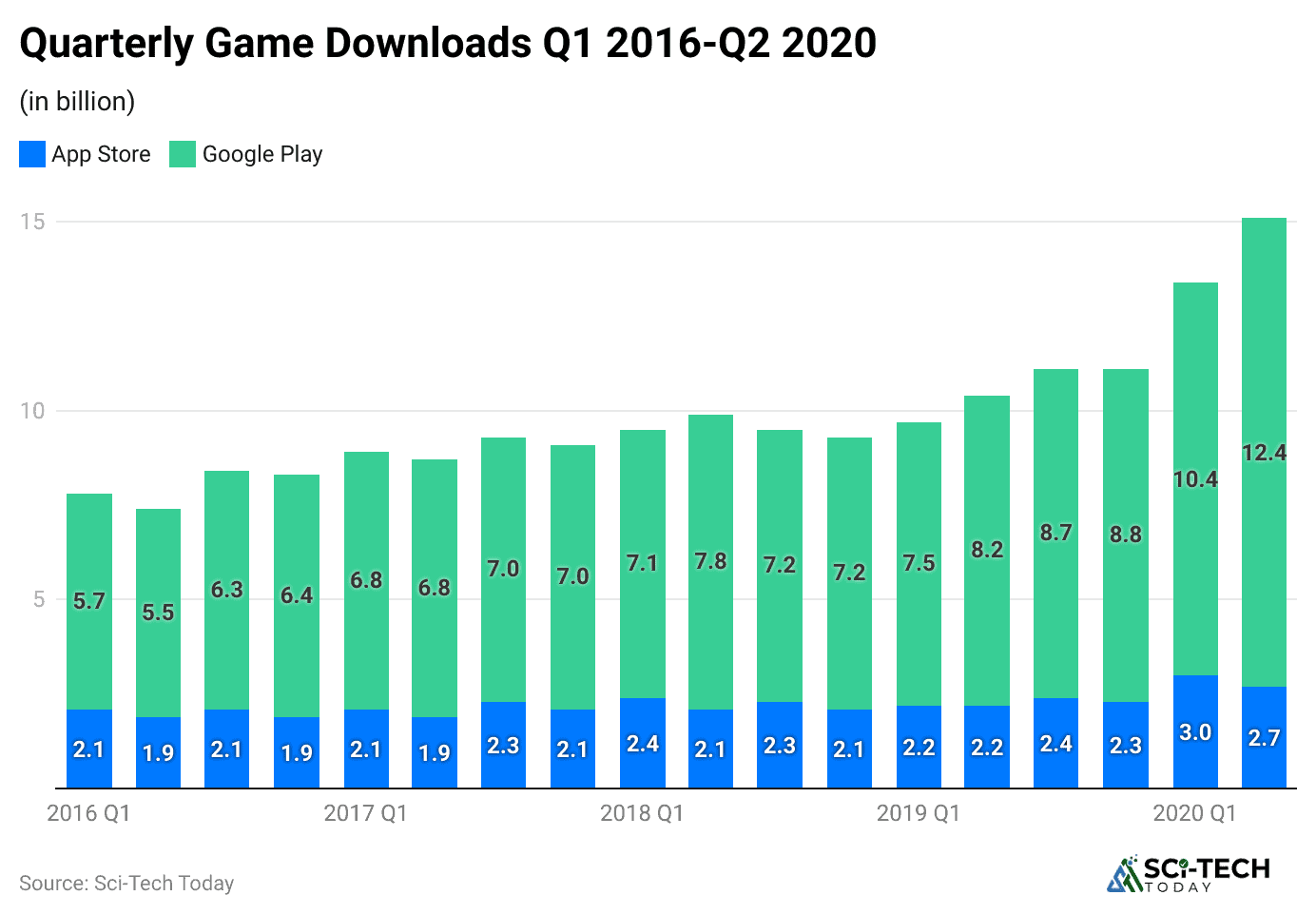
- The mid-core game Roblox was the most downloaded mobile gaming title in 2024, securing an enormous 221 million new downloads across both iOS and Android platforms.
- The hyper-casual puzzle title Block Blast surged in popularity to become the second most-downloaded game globally, registering a spectacular 217 million installs in 2024.
- The endless runner classic Subway Surfers continues to show incredible longevity, maintaining its popularity with 176 million downloads in 2024, keeping it among the top runners.
- Monopoly GO! set a new standard for monetization, leading the revenue charts with an estimated $2.2 billion in consumer spend, showcasing the power of board game mechanics combined with casino monetization.
- Tencent’s flagship MOBA, Honor of Kings, remained a revenue titan, earning a colossal $1.8 billion in 2024, primarily driven by its massive, loyal player base in mainland China.
- The match-3 puzzle game Royal Match completed the top three grossing games, pulling in a substantial $1.4 billion and demonstrating the continued, highly profitable strength of the puzzle genre.
- The Indian-centric title Ludo King showed the power of local relevance, securing 171 million downloads and cementing its place as a cultural phenomenon and a long-term favorite in India.
- The Battle Royale genre remains a core revenue driver, with titles like Free Fire and Free Fire MAX collectively garnering over 287 million downloads in 2024.
| Monopoly GO! | $2.2 Billion Highest Revenue | Casino/Board |
| Roblox | 221 Million Downloads Highest Downloads | Mid-Core/Platform |
| Honor of Kings | $1.8 Billion 2nd Highest Revenue | MOBA |
| Block Blast | 217 Million Downloads 2nd Highest Downloads | Puzzle/Hyper-casual |
| Royal Match | $1.4 Billion 3rd Highest Revenue | Puzzle |
| Subway Surfers | 176 Million Downloads | Arcade/Runner |
The Future of Mobile Gaming: Mobile Esports and Innovation
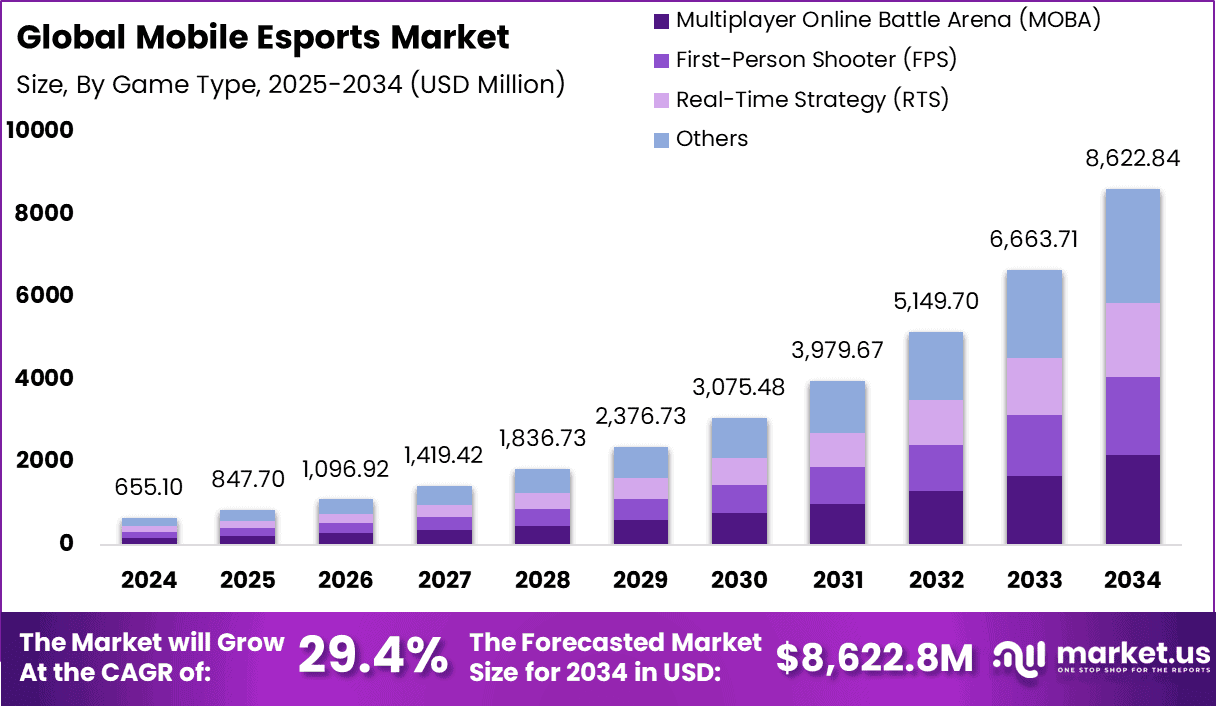
- The global Mobile Esports market is experiencing hyper-growth, with its market size projected to soar from $847.70 million in 2025 to a phenomenal $8.62 billion by 2034.
- This explosive growth rate is reflected in a Compound Annual Growth Rate CAGR of 29.4% for the mobile esports segment between 2025 and 2034, outpacing the growth of traditional PC and console esports.
- The Multiplayer Online Battle Arena MOBA subgenre is the undisputed leader in Mobile Esports, commanding over 25.1% of the entire mobile competitive market share in 2024.
- The mobile/eSports revenue stream is dominated by advertising, with the segment accounting for more than 30.6% of the market share due to its direct and effective way to reach a highly engaged, young audience.
- The global rollout of 5G networks is a critical driver, with global 5G subscriptions expected to exceed 5.4 billion by the end of 2029, accounting for approximately 58% of all mobile subscriptions worldwide.
- High-speed 5G connectivity is essential for the smooth operation of Cloud Gaming platforms on mobile, which are projected to grow at the fastest CAGR, enabling high-fidelity console-quality games without relying on local hardware.
- The emergence of Hybrid/Cross-Platform Gaming is a major trend, with the segment expected to see a blistering CAGR of 13% from 2025 to 2030, driven by player demand for seamless progression across mobile and PC/console.
- The use of Generative AI in game development is anticipated to become mainstream, with about 65% of gaming industry leaders forecasting the widespread adoption of AI for content creation and live operations in the near future.
| Mobile Esports | 29.4% CAGR 2025-2034 |
| 5G Subscriptions | 5.4 Billion by 2029 58% of all mobile subs |
| Cloud Gaming | Fastest Growing Segment |
| Hybrid/Cross-Platform | 13% CAGR 2025-2030 |
| AI Adoption | 65% of industry leaders forecast wide use |
Conclusion
Overall, these days, mobile gaming is the reigning champion of the digital entertainment industry, a $92 billion giant made by 3.2 billion users worldwide. The data unequivocally confirms its dominance, driven by robust monetization through sophisticated IAP mechanics and a booming in-game advertising market.
The market has stabilized and is on a clear path to continued growth, projected to hit $160 billion by 2030, largely due to the phenomenal spending power concentrated in genres like Strategy and RPG. While download volume is vast for casual games like Puzzle and Simulation, the major revenue generation is consolidated in core, live-service titles.
The future of Mobile Gaming is highly competitive and technologically advanced, with the explosion of mobile esports and the rollout of 5G and cloud services poised to transform the smartphone into a truly global, high-performance gaming console for billions. This segment is not just leading the gaming industry, it’s defining the future of digital entertainment on a global scale. I hope you like this article. Thanks for staying up till the end.
FAQ.
The mobile gaming market is enormous, consistently generating over $90 billion in revenue annually, making it the largest segment of the entire global gaming market, surpassing both PC and console gaming.
Yes, the mobile gaming market is projected to continue its growth, albeit at a more moderate pace compared to the boom during the pandemic. Growth is fueled by the rising adoption of smartphones, wider internet access, especially 5G, and advancements in technology like cloud gaming.
The mobile gaming audience is incredibly diverse. The average age of a mobile gamer is often cited as around 35, and approximately half of all mobile gamers are women. They are often characterized as casual players who play on the go.
The majority of mobile games use a free-to-play model, primarily generating revenue through two main methods:
- In-App Purchases IAP: Selling virtual goods like extra lives, currency, cosmetic items, or power-ups.
- In-App Advertising IAA: Displaying ads, often in the form of opt-in rewarded videos, banners, or full-screen interstitials.
While download charts are often dominated by Hyper-Casual games with simple, instant gameplay, the genres that generate the most revenue through in-app purchases are typically Strategy and Role-Playing Games RPGs. Puzzle games are also consistently popular.
Yes, mobile gaming is widely recognized as a major part of the overall gaming ecosystem. While some hardcore gamers might prefer PC or console, the scale, revenue, and technological sophistication of modern mobile games and mobile esports have cemented its status within the industry.
They are extremely important. High ratings and positive reviews directly impact a game’s visibility and credibility on the app stores, which is a major factor in convincing new users to download the game.
5G is crucial as it enables lower latency and faster download speeds, significantly improving the quality and reliability of online and cloud-streamed mobile games. Augmented Reality AR and Virtual Reality VR are also being integrated to offer more immersive and engaging experiences like Pokémon GO.
Mobile games often use design principles that encourage repeat play. These include easy-to-learn mechanics, short and satisfying gameplay loops, daily rewards, social competition, and clear progression systems, which create a compelling cycle that keeps players returning.
The key difference is the platform and player intent. Mobile games are optimized for touch controls and short, on-the-go play sessions accessibility. Console/PC games are generally designed for longer sessions, feature more complex controls, controllers/keyboards, and often prioritize advanced graphics and deep, narrative-driven content.

Jeeva Shanmugam is passionate about turning raw numbers into real stories. With a knack for breaking down complex stats into simple, engaging insights, he helps readers see the world through the lens of data—without ever feeling overwhelmed. From trends that shape industries to everyday patterns we overlook, Jeeva’s writing bridges the gap between data and people. His mission? To prove that statistics aren’t just about numbers, they’re about understanding life a little better, one data point at a time.









